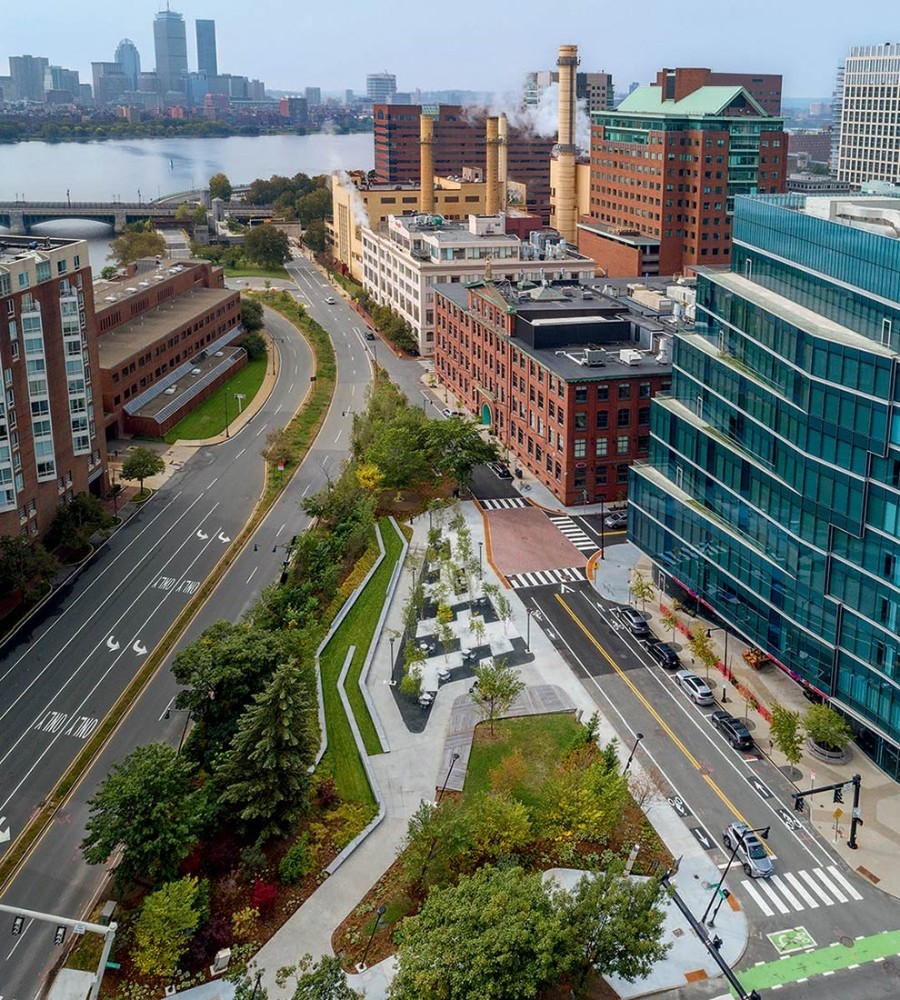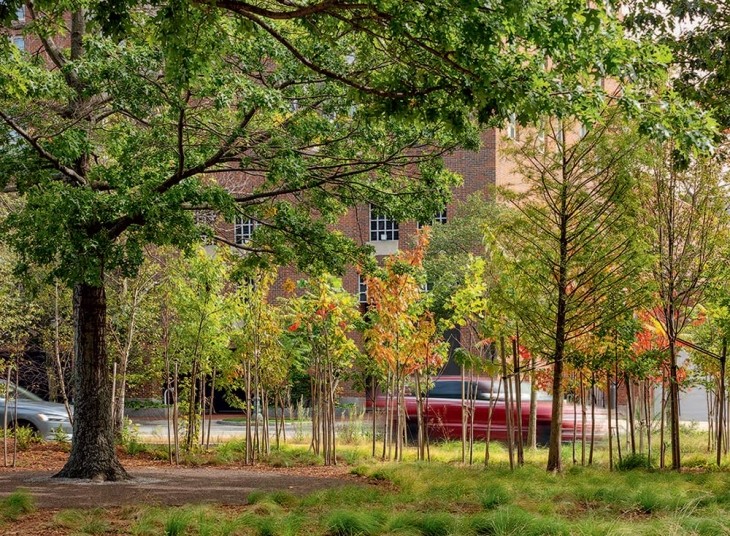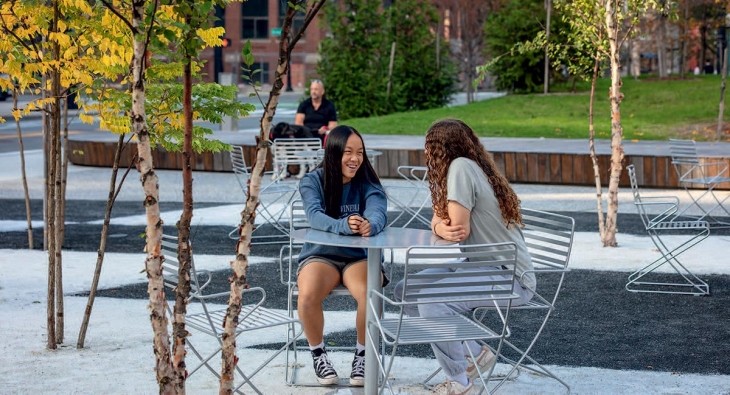
A steady parade of trucks loaded with gravel, cement, and dirt rumbles down Binney Street in Cambridge, Massachusetts, each day. There seems to be a construction site around every corner in the science and technology hub known as Kendall Square, which also appears to have more than the four corners its name suggests.
All those sharp angles can be hard on the eyes, and make a city-dweller yearn for lines that bend and branch. It is a relief, then, to come upon a little park amid the city bustle.
A robust Douglas fir marks one corner of the park, which is edged with the feathery foliage of arborvitae and the pointed leaves of oak and Japanese maple. A long, earthen berm planted with a grid of hardwood saplings blocks the view of traffic in the four lanes of Edwin Land Boulevard, which, along with Binney and First streets, forms the boundaries of the ¾-acre park. A sidewalk passes along the berm’s inside edge, tufted with glossy, long-leaved sedges and terraced with concrete walls and lawns. In the center, cafe tables and chairs are scattered among multistemmed birch and Kentucky coffee trees growing from black and white stabilized decomposed granite. The sun, as it rises over the Charles River, reflects off the glass and metal of surrounding buildings, through the trees, and onto lush beds of ferns.
Completed in 2023, Triangle Park is a new green space in a city striving to increase tree canopy by planting trees wherever it can, including along the industrial fringe of railyards and old garbage dumps, as well as in smaller fragments of neglected land between roads and buildings. In Cambridge’s 2019 Urban Forest Master Plan, city planners set a goal of 25-percent canopy cover in all neighborhoods, 60 percent along sidewalks, and a 50-percent reduction in hotspots – areas that are 2 degrees above the city average, or 92 degrees Fahrenheit on a 90-degree day. To attain these goals, the city is planting thousands of trees, redesigning traffic flows to make room for more trees, maximizing tree planting in existing parks, and has passed a tree protection ordinance. It is hard to walk through the streets these days without encountering a newly planted tree, or signage about a future tree.
Planning for City Forests
Andrew Putnam started working for the City of Cambridge in 2019, after several years as the campus arborist at Tufts University. As the city’s superintendent of urban forestry and landscapes, Putnam is directly involved in implementing the Urban Forest Master Plan. As part of this work, he has experimented with planting trees at higher densities than is typical for urban settings.
The standard practice of planting a street tree every 30 feet creates what Putnam calls “savannah conditions.” In the Northeast, trees grow better in clusters, he said, and a multilayered canopy offers more effective cooling. The forest plan calls for more trees to be planted in “groves,” with less separation from each other, and Putnam has planted 12 or 15 trees at a time, in close proximity to each other, in existing green spaces.
Encouraged by the successful growth of these urban groves, Putnam and other city leaders pushed landscape architects Chris Reed and Albert Chen of Stoss Landscape Urbanism to add more trees to their design for Triangle Park, which initially called for a hard-surfaced plaza taking up most of the space.
Reed, who has worked in urban landscapes from Boston and Los Angeles to Abu Dhabi and China, embraced the city’s challenge, revising the plan to include 400 trees of 15 different species, planted close together and intended to grow rapidly, self-thin, and regenerate. Part of the strategy was to overplant, and let the environment decide which trees would thrive.
The approach shares similarities with the Miyawaki method, a technique developed by the late Japanese ecologist Akira Miyawaki. Inspired by the sacred groves around temples in Japan and a desire to quickly revegetate hillsides after landslides and earthquakes, Miyawaki created “microforests” of native, fast-growing trees and shrubs, which he planted densely in enriched soil, in areas as small as 120 square feet. This work earned him the Blue Planet Prize in 2006 and has since inspired afforestation projects around the world.
The Miyawaki method was familiar to Cambridge city leaders by the time work began on Triangle Park. The city had already cooperated with the local nonprofit Biodiversity for a Livable Climate to plant two Miyawaki forests, with at least two more now planned or underway.
One of these exists a mile west of Triangle Park, at Greene-Rose Heritage Park, where silver maple, poplar, and sumac fill a raised bed at the edge of a space once occupied by commercial buildings. Cambridge’s first Miyawaki forest, Danehy Park, encompasses a tenth of an acre, planted on a former city landfill. Here, the Miyawaki forest is a circle of saplings and shrubs at the base of a small hill crowned with a few pines. From afar, it appears as a tiny island in a sea of mowed grass.
While the general concept is similar, Triangle Park differs from a Miyawaki forest in several ways. One difference is that the park’s soil has not been amended. After a century of industrial use, the soil on site was compacted and too contaminated to excavate. Instead, architects Reed and Chen built upward with the berm and surrounded some of the preexisting trees with rubberized, permeable surfacing that covers the contaminated soil but allows rainwater to infiltrate. Retention basins collect water from rain and snowmelt, which then flows to a sunken “lowland grove” at the triangle’s narrow point.
Another deviation from the Miyawaki method is that Triangle Park includes southern species not native to this region and plantings of larger trees. Along with New England species such as silver maple, shagbark hickory, linden, white oak, and gray birch, Reed and Chen added tulip tree, redbud, dawn redwood, and tupelo. In the understory, they planted a similar mix of native and non-native sedges, ferns, and shrubs. They selected this combination for its diversity and resilience, in addition to specific conditions at the site, including the available space, soil, and shade, as well as a changing climate.
“We’re not trying to transplant White Mountain National Forest,” said Chen. “But how can we get inspired by the forest community and encourage growth in urban conditions?”
A Forest Lost and Found
The latest enthusiasm for increasing urban tree coverage is on-brand for a metropolitan area with the first protected green space (Boston Common) and the first regional park system (Emerald Necklace) in the nation, within the first state to pass a law protecting public shade trees (in 1898).
In the late nineteenth century, Cambridge leaders considered developing parks on the filled mudflats of the city’s eastern edge at the mouth of the Charles River, including the land where Triangle Park stands now. Charles Eliot, a young landscape architect whose legacy includes cofounding the country’s first land trust, The Trustees of Reservations (in 1891), was responsible for the design.

But Cambridge abandoned its park plans and instead, in the twentieth century, welcomed industry to the neighborhood around Triangle Park, from synthetic rubber and ink manufacturing to a gas plant, printing press, and Boston & Albany Railroad spur. Dreams of factory lofts and shipping piers faded during the Depression. In the middle of the twentieth century, the land where Triangle Park now stands hosted a sequence of chemical, automotive, and trucking companies, then a pet supply store. Buildings came and went as visions changed. By the twenty-first century, all that was left on the lot were a few trees surrounded by construction vehicles, broken pavement, and gravel.
Eventually, as Kendall Square emerged as a global biotechnology capitol, the triangle lot came under the ownership of California-based Alexandria Real Estate Equities, the self-described “leading owner, operator, and developer of collaborative mega campuses for life science companies in the nation’s top innovation clusters.” As part of a rezoning negotiation, Alexandria gave the triangle back to the City of Cambridge in 2012, and the city once again decided to make a park on the site, initiating years of studies, surveys, and plans.
Susan Barron, a resident of The Esplanade condominiums across the street, was skeptical. She remembers thinking, You’ve gotta be out of your mind if you think you’re gonna make a park out of this crappy place. “The place was a wreck,” Barron said. “It was nothing.”
While Barron’s apartment overlooked the Charles River, many others in The Esplanade had a view of the triangle. A few tried to improve the lot. At one corner on Binney Street, George and Mary Pugh tended what they called “an old-fashioned southern garden,” planting tulips and azaleas beneath the struggling Douglas fir in an attempt to beautify what resident Jane Hilburt-Davis described as “a very ugly spot.”
Ugly – and hot.
With only 17-percent canopy cover – the lowest of any Cambridge neighborhood – the Triangle Park area had become a heat island as summer temperatures reached new highs and the park planning process dragged on. By 2020, not just trees but forests had become an obvious answer to those concerned about climate change, as well as the inequity in canopy cover across cities. At the same time, the pandemic had increased scrutiny on outdoor spaces, while across the region – from Cambridge to the Boston neighborhoods of Charlestown, Roxbury, and Dorchester – residents protested the cutting of mature trees for road widening and construction projects.
Finding Connections – and Community
Cambridge, Boston, and other cities have scaled up urban forestry staffing while also supporting the grassroots organizations and people who had long been advocating for improved urban forests. In her support for the Boston Tree Alliance, which coordinates the activities of many of these organizations, Boston Mayor Michelle Wu has emphasized the trust-building nature of trees, of parks as spaces for neighbors to be in connection with one another, of forests as possibly “the last place where we are truly in community with everyone.”
Mini-groves and microforests are part of a rapidly growing movement, advocated by those concerned with biodiversity, beautification, climate change, racial justice, food sovereignty, mental health, student learning, and civil discourse.
“Everyone has a relationship with trees,” said David Meshoulam, who grew up in Cambridge and, in 2016, cofounded the nonprofit Speak for the Trees in Boston, a member of the Boston Tree Alliance, whose mission is to expand tree canopy as a way to heal division. “We plant trees where they are needed in people’s daily routines, in yards and streets.”
Speak for the Trees board president and landscape designer Liz Luc Clowes has helped create several urban microforests in the region, including a “healing forest” at a charter school in Dorchester, a Miyawaki forest in Mattapan, and five permaculture-inspired “food forests” featuring nut- and fruit-bearing trees across Boston, the city where she grew up. So far, she has received only positive feedback. She believes microforests are part of the future of cities, because of both climate change and the connection people find among parks and other outdoor spaces.
“We’re feeling the heat,” said Clowes. “But if we do it right, people don’t go to the microforest just because it’s cooler. It becomes a third space where communities are more resilient, because they found each other.”
Back in Cambridge, Chris Reed holds Triangle Park as an example of how making cities more livable and healthier means “reimagining the leftovers” of past industry, infrastructure, and business as “multifunctional, vibrant landscapes.”
If any place has the capacity for such reimagining, it is Kendall Square.
A New Urban Silviculture
Planting is just the beginning of a microforest. Studies have shown that without maintenance, microforests tend to develop a single-layered, even-aged structure of overstory trees, especially where nearby seed sources are limited, or where invasive species take root. With care and attention, however, in as little as 10 years, a microforest can become self-sustaining, maintaining vertical and horizontal dimension as some trees die and the understory regenerates. In the case of Triangle Park, the city has committed to ongoing weeding, watering, mulching, and pruning.
Still, the question arises: Is this a forest?
According to the Merriam-Webster Collegiate Dictionary, a forest is “a dense growth of trees and underbrush covering a large tract.” The first part, density, seems to apply to microforests. Miyawaki described a true forest as having an interior, with growth extensive and dense enough to block wind and sun. At the Danehy Park forest, it is hard to see from one side through to the other. Three years after planting, it has grown into an impenetrable thicket, although the trees have not yet formed an overstory.
The second part of the definition, large, is relative. What seems like a pixel in a sprawling matrix of skyscrapers, bridges, and highways can loom massive in the psyche of a neighborhood. Birds flock to the microforests. At Rose-Greene, the air fills with the songs and calls of house sparrows, jays, and cardinals as they fly between new and established shrubbery.
Within Triangle Park, there are views of trees in all directions, creating a feeling both more embracing and more expansive than might be expected from a single acre. The lower density of trees, while more transparent, makes the woods accessible, inviting. Visitors who walk among the dawn redwoods, oaks, and birches, and look down at the maidenhair ferns and rosy sedge may forget, briefly, the surrounding city.
Perhaps, after all, a forest is defined by the perspectives of those who know it, including the residents of The Esplanade who waited so long for the green to emerge. Susan Barron calls Triangle Park “a miracle,” and to Jane Hilburt-Davis, the park is “magnificent.”
“Is it a forest?” Hilburt-Davis asked. “Not yet. But that’s okay. It looks like one, it acts like one.”




Discussion *